Key takeaways:
- Selective mutism is rooted in anxiety and can persist from childhood into adulthood, making social interactions challenging.
- Coping mechanisms, such as breathing exercises and visualization techniques, empower individuals to manage anxiety and build confidence in communication.
- Professional therapy can provide valuable tools and insights, helping individuals understand anxiety patterns and develop effective coping strategies.
- Sharing personal experiences fosters community and encourages others to confront their own challenges, highlighting the importance of vulnerability in the healing process.
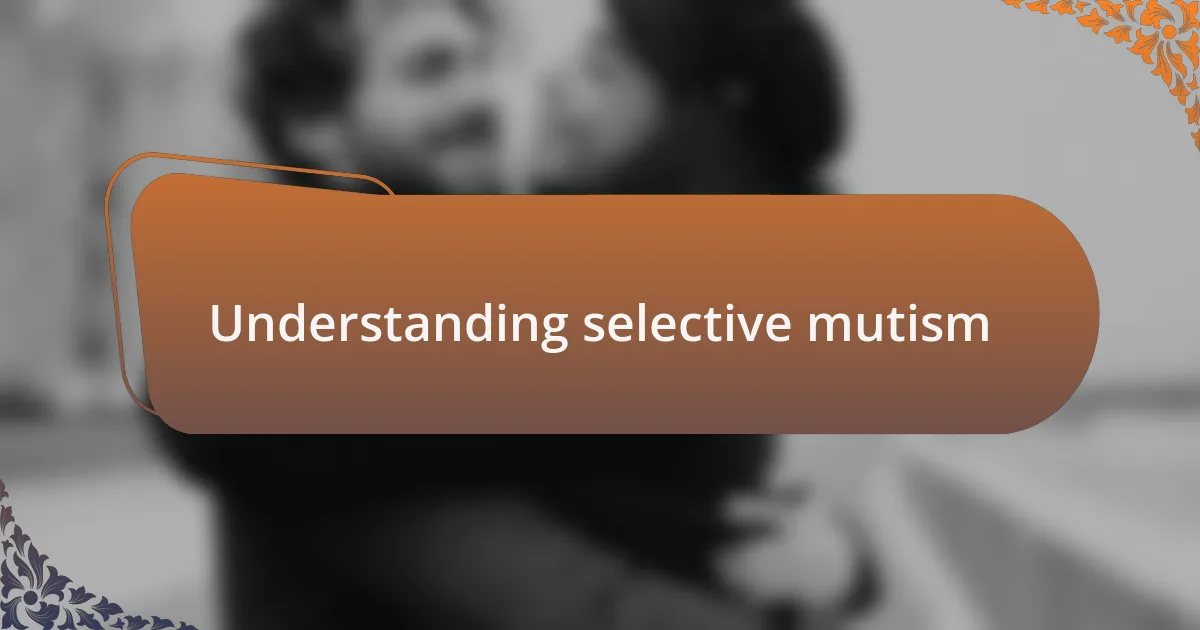
Understanding selective mutism
Selective mutism is more than just a reluctance to speak; it often stems from deep-seated anxiety and a feeling of being overwhelmed in social situations. I still remember the discomfort that washed over me when I was expected to speak in a group. It felt as if the words were trapped inside me, and the weight of silence was crushing.
This condition typically appears in early childhood, but its effects can linger into adulthood, creating challenges in daily interactions. Have you ever felt an urge to speak but found your voice silenced by fear? I can relate. Each time I faced a social setting, a part of me yearned to contribute, yet panic would tighten my throat, leaving me feeling isolated.
Understanding the emotional landscape of selective mutism reveals a complex interplay of fear, social anxiety, and desire for connection. It’s not merely about choosing not to talk; it can feel like navigating a labyrinth of emotions and expectations. I often felt like an observer, wishing to engage but caught in a web of my own anxiety. Recognizing these feelings is crucial for anyone grappling with selective mutism—it’s a step toward empathy and support.
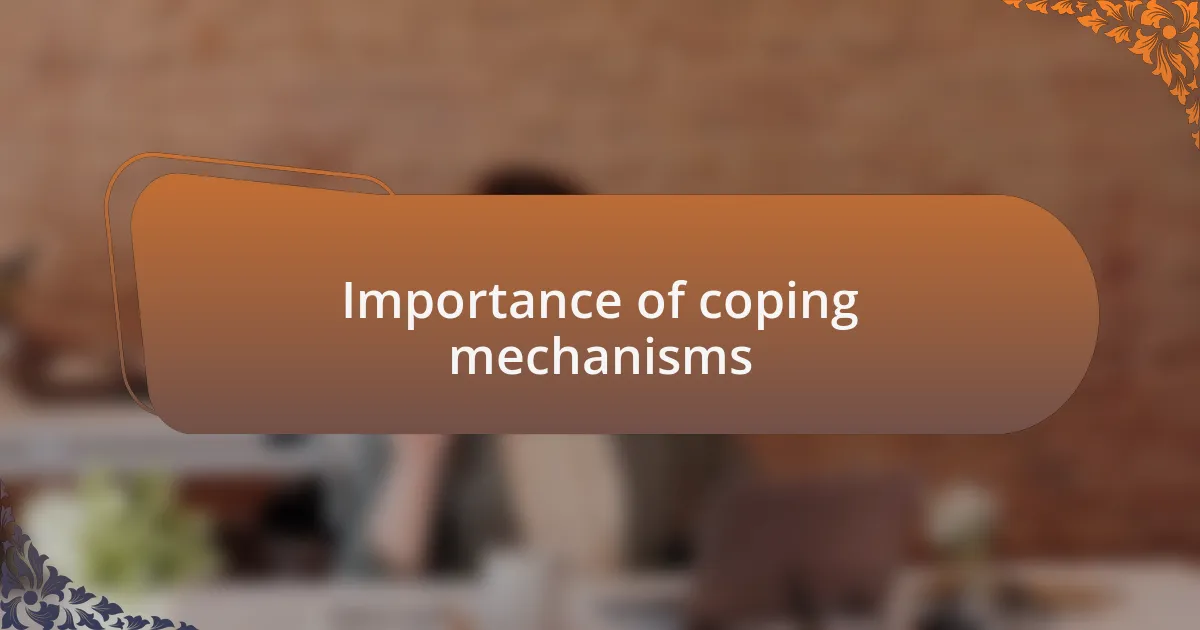
Importance of coping mechanisms
Coping mechanisms are vital for those facing selective mutism, as they provide essential tools for managing overwhelming feelings. I remember the first time I found something that worked for me—this small exercise of taking deep breaths before speaking in any social situation. It was a simple step, yet it felt like reclaiming a piece of myself, reducing the weight of expectation that often loomed over me.
Having these mechanisms in place creates a safety net that allows for gradual exposure to speaking opportunities without being paralyzed by fear. Do you ever wonder how a simple visualization technique or a mantra can transform anxiety into calmness? I do! Each time I employed these strategies, I felt a shift in my mindset, making me more equipped to engage, even if it was just a whisper at first.
The significance of coping strategies extends beyond immediate relief; they lay the groundwork for long-term confidence and resilience. Finding my voice felt less daunting when I knew I had these methods to lean on. Implementing them not only helped me in conversations but also fostered a sense of self-acceptance, encouraging me to celebrate each milestone, no matter how small.

Common coping strategies
Finding effective coping strategies can be a game-changer for anyone dealing with selective mutism. One approach that really resonated with me was journaling. I poured my thoughts and feelings onto the pages, and it felt like my voice was finally heard—even if it was just by me. Have you ever experienced that relief when you finally articulate what’s inside? I believe writing can serve as a bridge to self-understanding.
Another helpful technique I discovered was role-playing conversations with a trusted friend or family member. By simulating social situations in a safe environment, I learned to navigate my anxiety without pressure. It was comforting to practice with someone who understood my challenges. I still remember the first role-play session—it was awkward at first, but as we laughed and stumbled together, the experience became less daunting. Isn’t it amazing how a little practice can create a ripple effect of confidence?
Mindfulness exercises also play a crucial role in managing anxiety linked to selective mutism. I often took moments to focus on my surroundings, engage in deep breathing, or even listen to calming music before entering social settings. One time, I took a moment to feel the textures around me and the sounds in the room, which really grounded me. I found that these small moments of mindfulness transformed my anxiety into a state of awareness. Have you tried something similar? It can truly make a difference in calming those swirling emotions.
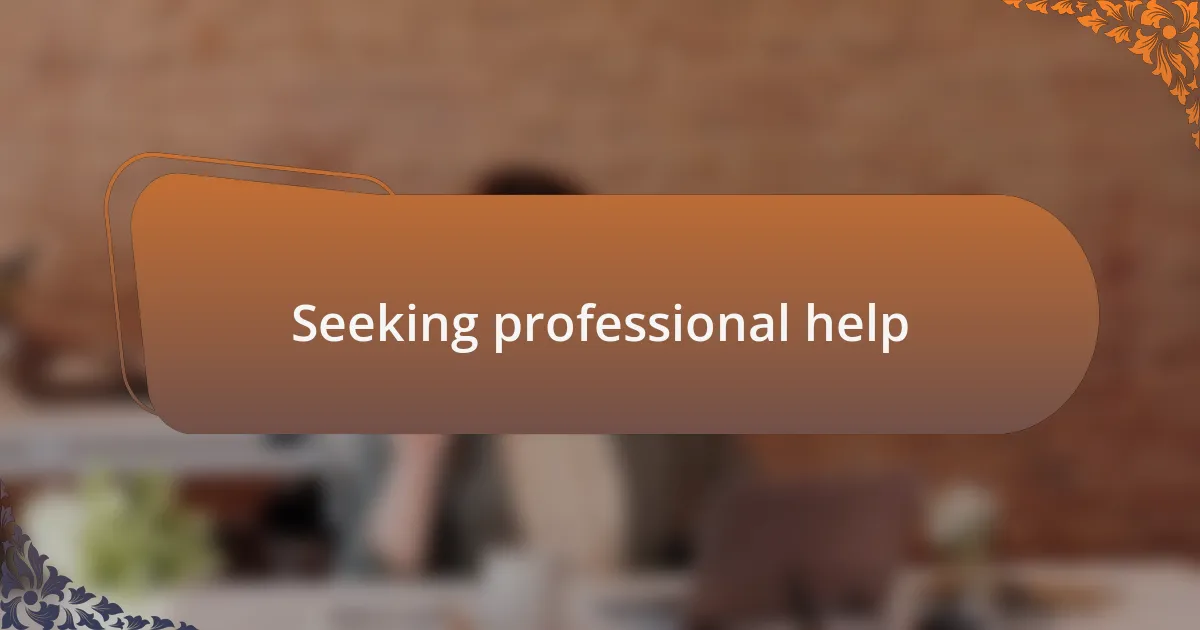
Seeking professional help
Seeking professional help can often feel like a daunting step, especially for someone struggling with selective mutism. When I first considered therapy, I was filled with uncertainty. Would talking to someone really help? However, meeting with a therapist experienced in this area opened my eyes to coping strategies I hadn’t even considered. It was in those sessions that I began to recognize the patterns of my anxiety and the roots of my silence.
There’s something incredibly validating about having a professional guide you through your experiences. I remember one particular session where my therapist introduced cognitive-behavioral techniques. At first, I was skeptical. Could these strategies really change anything? But gradually, I discovered how reframing negative thoughts could shift my perspective. Each breakthrough, no matter how small, felt like reclaiming a bit of my voice.
It’s also important to find a therapist who resonates with your journey. In my search, I realized that a good connection made all the difference. Have you ever felt that spark when you meet someone who truly understands? Once I found that match, I felt safe expressing my fears, and it became easier to practice communication skills outside of our sessions. Professional help isn’t just about having someone to talk to; it’s about having a partner in your journey toward self-expression.
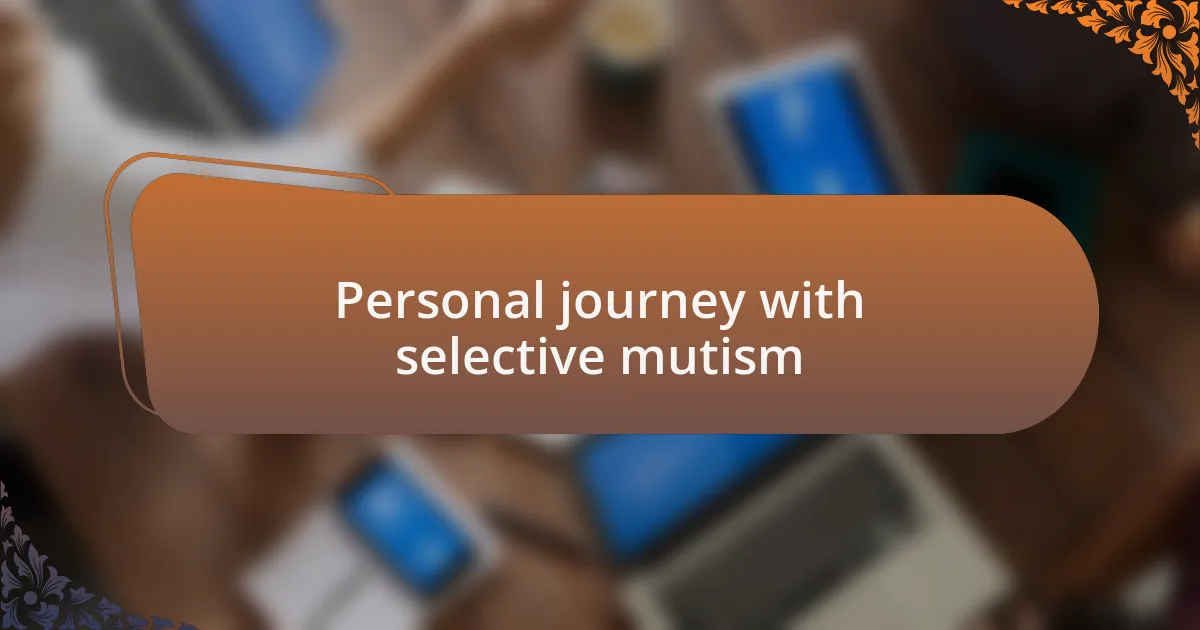
Personal journey with selective mutism
The journey with selective mutism has been deeply personal for me, often filled with moments of frustration and introspection. I vividly recall standing at the edge of a schoolyard, feeling a knot in my stomach while watching others chat effortlessly. Didn’t they realize how daunting it felt to answer a simple question? In those moments, I wished for a way to bridge the gap between my thoughts and the words that refused to come out.
I remember one afternoon during an art class, when I discovered the power of creative expression. As I painted, the swirling colors seemed to give voice to my silent struggles. It was a revelation: I didn’t always have to speak to be heard. This insight shaped my coping mechanism; I started focusing on different forms of communication. Have you ever stumbled upon a method that resonates so deeply it feels like it unlocks a part of you? For me, art became that key.
Navigating selective mutism has taught me that progress doesn’t always come in leaps. There were days when even writing felt like an insurmountable challenge. But with patience and persistence, I learned to celebrate the little victories, like whispering my name to a classmate or speaking up in group discussions. Each step forward seemed to affirm that my voice—though sometimes quiet—was worthy of being expressed. What if your small steps could lead to significant change? I’ve found that sometimes, it’s those tiny victories that lay the foundation for greater strides in self-expression.
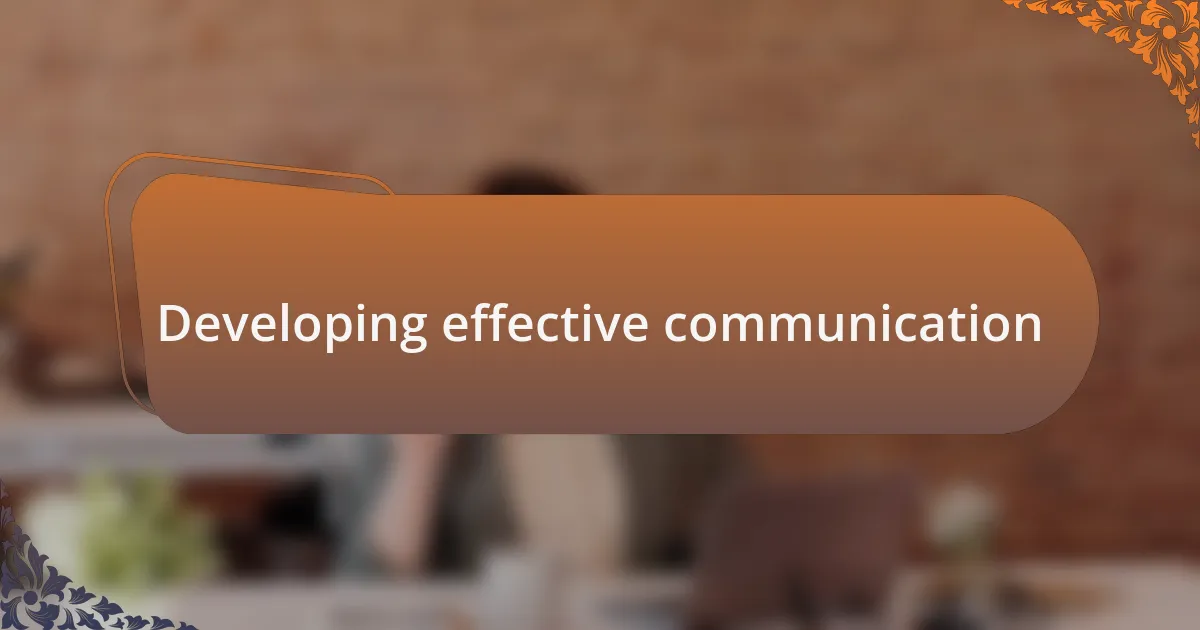
Developing effective communication
Effective communication involves understanding not just what I want to express but also how others might perceive my words. When I began to experiment with nonverbal cues, such as gestures or facial expressions, I noticed a shift in my interactions. It was enlightening to realize that communication transcends words—how often do we underestimate the power of a smile or a nod?
There was a time when I hesitated to ask questions in class, fearing the attention it would draw. However, I slowly learned that raising a hand could be a bridge to understanding. I vividly recall one instance where a brief note passed to a friend unlocked a moment of connection, easing my anxiety like a gentle breeze. Can a simple scribble become a lifeline? In my experience, it absolutely can.
As I practiced different methods of expressing myself, I discovered the art of active listening. Engaging with others by truly hearing their voices made me feel more confident and connected. There were moments when I found myself laughing at a shared joke, even though I didn’t speak much; the sheer joy of belonging felt like a triumph. Isn’t it fascinating how the dynamics of communication can shift when we start to listen as much as we speak?
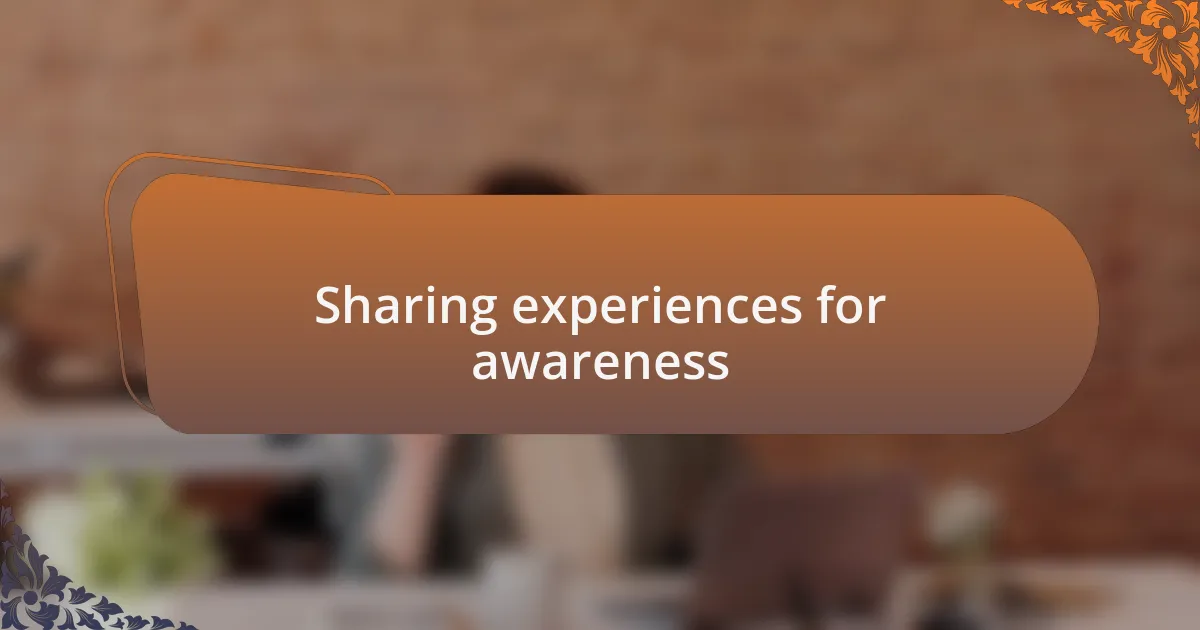
Sharing experiences for awareness
Sharing experiences can illuminate the often-overlooked nuances of selective mutism. I remember a poignant moment when I shared my journey at a support group. Hearing others recount their struggles encouraged me to confront my feelings, and it became a therapeutic exchange that deepened our understanding of one another. Have you ever felt the relief of realizing you’re not alone in your experiences?
When we openly discuss the challenges of communication, it fosters a sense of community. I once received a heartfelt message from someone thanking me for sharing my story online; it showed me how a single voice can resonate and spark courage in others. Have you ever considered how your own experiences could inspire someone else facing similar hurdles?
Sharing personal anecdotes can be transformative not only for the listener but also for the storyteller. By recounting moments of vulnerability—like the time I struggled to speak at a family gathering—I found empowerment in my honesty. It made me wonder: what if every shared story became a stepping stone for someone else’s journey towards finding their voice?